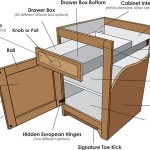How To Install Trim On Top Of Kitchen Cabinets
Adding trim to the top of kitchen cabinets is a relatively simple way to enhance the aesthetics of a kitchen space. This decorative element, often referred to as crown molding, cabinet molding, or upper cabinet trim, provides a finished, custom look that can significantly elevate the overall design. The process, while straightforward for those with some carpentry experience, requires careful planning, precise measurements, and attention to detail to ensure a professional-looking result.
Before embarking on the project, it's crucial to understand the various types of trim available. Crown molding is the most common choice, characterized by its ornate, decorative profile. However, other options include simple cove molding, quarter-round, or even custom-designed trim pieces fashioned from lumber. The selection should complement the existing cabinet style and the overall design aesthetic of the kitchen. Considerations should include the height of the ceiling, the existing cabinet color and style, and the desired level of formality or informality in the space.
Furthermore, understanding the necessary tools and materials is paramount for a successful installation. These typically include a miter saw, a measuring tape, a level, a stud finder, a nail gun (or hammer and nails), wood glue, caulk, wood filler, sandpaper, and paint or stain to match the existing cabinetry. The specific type and quantity of materials will vary depending on the size of the kitchen, the length of the trim, and the complexity of the installation.
This article will detail the step-by-step process of installing trim on top of kitchen cabinets, emphasizing best practices and highlighting potential challenges. It will cover everything from initial planning and preparation to the final finishing touches, providing a comprehensive guide for achieving a professional-looking result.
Planning and Preparation
The initial phase of the project involves meticulous planning and preparation. This stage is critical because errors in measurement or material selection can lead to significant problems later in the installation process. This phase encompasses several key steps, including measuring the cabinet tops, determining the desired trim profile, purchasing the necessary materials, and preparing the work area.
The first step is to accurately measure the length of the cabinet tops where the trim will be installed. This should be done with precision, paying close attention to corners and any irregularities in the cabinet layout. It is advisable to add a few extra inches to the measurements to account for mitered cuts and potential errors. These measurements will be used to determine the amount of trim required for the project. When measuring, account for outside corners and inside corners. Outside corners will require a longer piece of trim than inside corners. It is always best to buy a little extra trim than to come up short.
Next, the selection of the trim profile is crucial. This is a matter of personal preference, but it should be aligned with the overall design of the kitchen. As previously mentioned, crown molding is a popular choice, but simpler profiles like cove molding or quarter-round can also be effective. Consider the height of the ceiling when selecting the trim profile. Higher ceilings can accommodate larger, more ornate trim, while lower ceilings may benefit from a simpler, less imposing design.
Once the trim profile is selected, the necessary materials can be purchased. This includes the trim itself, as well as any other supplies needed for the installation, such as wood glue, nails, caulk, wood filler, sandpaper, and paint or stain. It is important to choose high-quality materials to ensure a durable and long-lasting result. Ensure that the paint or stain matches the existing cabinetry as closely as possible. Minor variations in color can be noticeable and detract from the overall appearance.
Preparing the work area is another important aspect of the planning phase. This involves clearing the countertops and surrounding areas of any clutter, covering the floors with drop cloths to protect them from dust and debris, and ensuring adequate lighting for the installation process. Consider using painter's tape to protect the walls and cabinets from accidental scratches or paint splatters. It is also advisable to wear safety glasses and a dust mask to protect yourself from flying debris and sawdust.
Finally, before beginning the installation, it is prudent to inspect the cabinet tops for any imperfections or irregularities. If there are any gaps or uneven surfaces, they should be addressed before attaching the trim. This can be done by filling the gaps with wood filler or sanding down any uneven areas.
Cutting and Installing the Trim
The next phase involves the cutting and installation of the trim. This requires precision and attention to detail to ensure that the trim fits snugly against the cabinets and that the mitered corners are seamless. This phase encompasses several key steps, including cutting the trim to the correct lengths, creating mitered corners, attaching the trim to the cabinets, and checking for level and alignment.
Cutting the trim to the correct lengths is a critical step. Use the measurements taken during the planning phase to determine the length of each piece of trim. It is always better to cut the trim slightly longer than necessary, as it can always be trimmed down later. Use a miter saw to make precise cuts at the desired angles. Miter saws are designed to make accurate cuts at various angles, which is essential for creating seamless mitered corners.
Creating mitered corners is one of the most challenging aspects of this project. Mitered corners are formed by joining two pieces of trim at a 45-degree angle. This requires precise cuts and careful alignment. Use a miter saw to cut the trim at a 45-degree angle for both inside and outside corners. For outside corners, the cuts should be made so that the long point of the trim faces outwards. For inside corners, the cuts should be made so that the long point of the trim faces inwards. It is helpful to practice making mitered cuts on scrap pieces of trim before cutting the actual pieces.
Once the trim is cut to the correct lengths and the mitered corners are created, the trim can be attached to the cabinets. Apply a bead of wood glue to the back of the trim and then carefully position it against the cabinet top. Use a nail gun to secure the trim in place. If a nail gun is not available, a hammer and nails can be used, but be careful not to damage the trim or the cabinets. Use finishing nails, which have smaller heads that can be easily concealed with wood filler. Drive the nails in at a slight angle to provide a stronger hold.
After attaching the trim, check for level and alignment. Use a level to ensure that the trim is straight and level. If necessary, make adjustments by adding shims or re-positioning the trim. Proper alignment is crucial for a professional-looking result. Misaligned trim can be visually jarring and detract from the overall appearance of the kitchen.
Repeat this process for all of the cabinet tops, ensuring that the trim is properly aligned and securely attached. Pay close attention to the mitered corners, ensuring that they are tight and seamless. If there are any gaps in the mitered corners, they can be filled with wood filler later in the process.
Finishing Touches
The final phase of the project involves the finishing touches. This is where the trim is prepared for painting or staining, and any imperfections are addressed. This phase encompasses several key steps, including filling nail holes and gaps, sanding the trim, caulking seams, and painting or staining the trim.
The first step is to fill any nail holes or gaps with wood filler. Use a putty knife to apply the wood filler to the holes and gaps, pressing it firmly into place. Allow the wood filler to dry completely before proceeding to the next step. Wood filler is available in a variety of colors, so choose a color that closely matches the trim or the cabinets. Overfilling the holes and gaps is preferable to underfilling them, as the excess wood filler can be easily sanded away.
Once the wood filler has dried, sand the trim smooth. Use fine-grit sandpaper to sand down any rough edges or imperfections. Be careful not to sand too aggressively, as this can damage the trim. The goal is to create a smooth, even surface that is ready for painting or staining. Sandpaper with a grit of 220 is generally recommended for this step.
Next, caulk any seams or gaps between the trim and the cabinets or walls. Caulk provides a seamless transition and prevents moisture from penetrating behind the trim. Use a caulk gun to apply a bead of caulk along the seams and gaps. Smooth the caulk with your finger or a damp cloth. Paintable caulk is recommended, as it can be painted over to match the trim or the cabinets. Excess caulk can be removed with a damp cloth or a putty knife.
Finally, paint or stain the trim to match the existing cabinetry. Apply a primer coat before painting or staining to ensure proper adhesion and coverage. Use high-quality paint or stain that is designed for wood surfaces. Apply multiple thin coats of paint or stain, allowing each coat to dry completely before applying the next. This will provide a smoother, more durable finish. Follow the manufacturer's instructions for drying times and application techniques.
By following these steps carefully, anyone with basic carpentry skills can successfully install trim on top of kitchen cabinets and achieve a professional-looking result. The added trim will enhance the aesthetic appeal of the kitchen and create a more finished, custom look.

Adding Crown Molding To Kitchen Cabinets Young House Love

Install Trim Above Cabinets Madness Method Kitchen Cabinet Crown Molding

How To Add Crown Molding Kitchen Cabinets Abby Organizes

Installing Kitchen Cabinet Crown Molding

Moldings Finish And Trim With Gary Striegler Part 14

Adding Moldings To Your Kitchen Cabinets Remodelando La Casa

How To Install Crown Molding On Kitchen Cabinets

Installing Crown Molding On Kitchen Cabinets Diy Cabinet

Attaching Trim To A Cabinet Top

How To Add Crown Molding Kitchen Cabinets Abby Organizes








